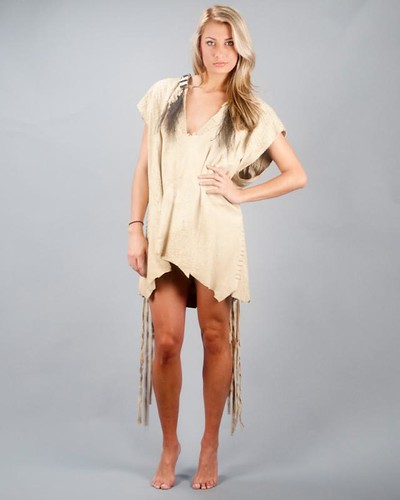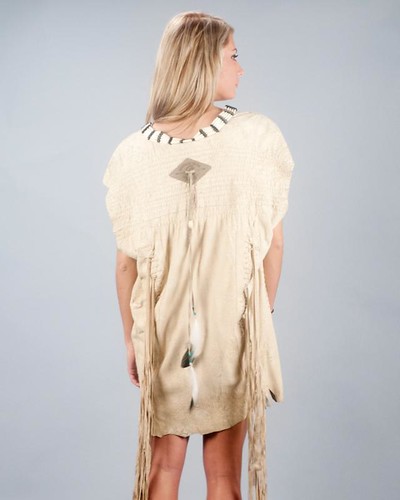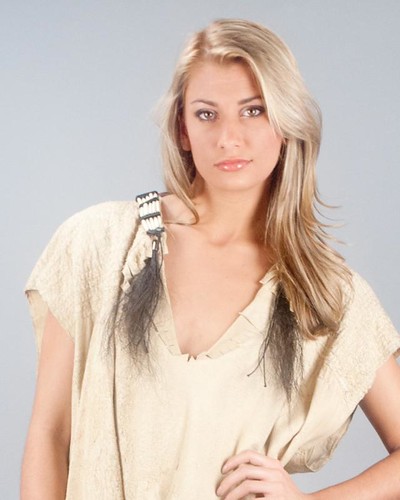( – promoted by navajo)
On occasion, I peruse fashion sites, and I’ve noticed a fair amount of cultural appropriation recently. One such caught my eye today; it’s by D&G, a label of Dolce and Gabbana, and they claim it is a “tribal dress”.
The garment is made of goatskin and looks like utter crap. In my Nimisenh (elder sister) Aji’s words, “no self-respecting ikwe would be caught dead in something so grotesque”. It’s expensive crap, too; the original price was $1450, but it was on sale for a “mere” $150.
I personally have better things to spend my limited resources on than this, but it’s time all of us rose up to say “Enough, damn it!” to cultural appropriation.
Personally, I don’t much know how we can do this other than writing to the offenders en masse and letting them know that this is not cool, or fashionable, and is something that makes them look really bad rather than chic.
Their corporate address in the U.S. is:
Dolce&Gabbana USA Inc.
148 Lafayette Street
New York, Ny 10013
Tel.1-212-750-0055
Their main HQs seem to be in Milan, and those addresses are:
Dolce&Gabbana S.r.l.
Registered office:
Via S.Cecilia, 7
20122 Milan
Italy
Tel.+39-02 7742710
Group’s headquarters
Via Goldoni,10
20129 Milan
Italy
Tel.+39-02 774271
Head office for the D&G brand
Via Broggi, 23
20129 Milan
Italy
Tel. +39 02 2772771
I have been unable to find a good corporate email address but will update here if I can locate one.
So you can see what sort of cultural appropriation is going on, here are pictures. Thanks to navajo for making them small enough to include here!



I hope you’ll join me in keeping an eye out for cultural appropriations from all indigenous peoples if you pay attention to the dominant culture at all, and will also join me in protesting it whenever you do see it. If Dolce & Gabbana gets enough of a backlash from Native peoples and allies, we can hope (perhaps vainly) that they’ll think twice about stealing another’s culture to make up some white fantasy for wannabes. I’ll continue to keep my eye out and post when I see further outrageous examples.
I also want to give a shout-out to Native Appropriations, an excellent blog dealing with just this subject. They’re now linked as Blog Brothers on the right-hand side of the page, thanks again to navajo.
Wherever it happens, cultural appropriation is wrong. Cultural appropriation just to make a fashion statement is a way to make money and nothing else, money which is never shared with those whose cultures have been appropriated. After Tuesday’s election, I personally am in a scrappy mood and you may be, too, so let’s fight back!
Those outfits are a travesty.
the whitest, blondest woman available to model said “fashion.” It’s enough to make you lose your lunch (from either end).
*Full disclosure: I’m a 49 yr. old Black woman who has seen my fair share of cultural appropriations of all kinds over the years….
Welcome, aquarius40, and thanks for your comment. To add insult to injury, the diamond-shaped patch on the back of the garment reads “Buffalo Tribe”!
I do buy from sales on occasion and the sites at which I spend my money use white, Asian-American, African American, and mixed-race models almost interchangeably.
Confession: feather earrings may be another cultural appropriation and beadwork almost certainly is, but the feather earrings I used to wear back in the early 70s and the beadwork earrings and necklaces I wore in the 80s was all stuff I made myself. The feathers were mallard duck feathers, gathered at a local wild duck pond, and the beadwork stitches I figured out myself by studying beadwork made by others (always purchased directly from a street artist rather than some shop with cheapie imports). Some stitches I came up with on my own rather than by studying anything. I did it more to look like a Deadhead than to steal from Indians but it may have been cultural appropriation nonetheless. I don’t know if it is cultural appropriation if it’s 100% your own artistry, made for yourself. I’d love to get opinions on this.
A friend and I also used to make earrings way back when out of the emblems on Coors beer cans. They looked like etched sterling silver but were free. Of course we never bought Coors beer. Bleah!
Hey, new poster here. I’m interested in menswear for the general public in north and south America that references Native American and Mexican aesthetics, uses traditional materials, workmanship, and provides employment for artisans and designers on both sides of the border. I agree the above is tacky bullshit, but is there a way to interpret Native designs and aesthetics for the general public that is not appropriation? Can someone give me references for designers Native and non-Native that are working with Native themes for modern street wear (other than t-shirts)?
My motivation is, living in Mexico much of the time, I see that the young Mexicans don’t want to dress like their grandparents, so older artisans aren’t passing down their knowledge. Younger Latino/Native folks are so often on the move from pueblo to city, and from south to north and back, they need clothes that work equally on the city street, in the pubelo, in an office, or on the farm. With updated street-wise designs, the new generation can be enticed into learning the old techniques and materials, and the older generation can pass on their knowledge. Everyone can make some money selling clothes. So hopefully, this would also stimulate traditional/sacred textile work. If you’re getting paid to do sportswear for export, you have cash to buy supplies to make serious garments for the local saints and festivals.
since most SW styles are either Mexican or Indian I doubt we can affect them much, although the truly grotesque like the ones pictured above need to be questioned and/or ridiculed.
As for your question there are quite a few native designers around wwho use tribal themes. But I don’t know them being an old rez dog whose ‘fashion’ consists of jeans. I do wear ribbon shirts for powwow dress up though.
the old ladies would be throwing sticks and rocks at any woman who showed up wearing that hide. But, my brother-in-law would like it.
As for answering your question, I don’t know much about how Native designers are working with Native themes for street wear. I’m going to copy your comment and post it to our open thread on the front page, where more of our members will be more likely to see it. I’ll bet you get some answers there.
Thanks for asking, and again, welcome. Good to have you here!
I’ve started asking around, and got a few contacts for Native clothing designers. First Nations have some of the most amazing textiles on the planet. It seems a shame that Native aesthetics are not better represented in the clothing industry. I’m thinking clothing production would be a good sustainable business to bring to the res. Give people some good paying work to be proud of. I’m gonna try and organize some Native and Latin designers (I live in Mexico part time and have family in Ecuador) and make a website where they can sell their stuff and get some recognition as a group. Anyone want to help can hit me up. corin@putazo.net